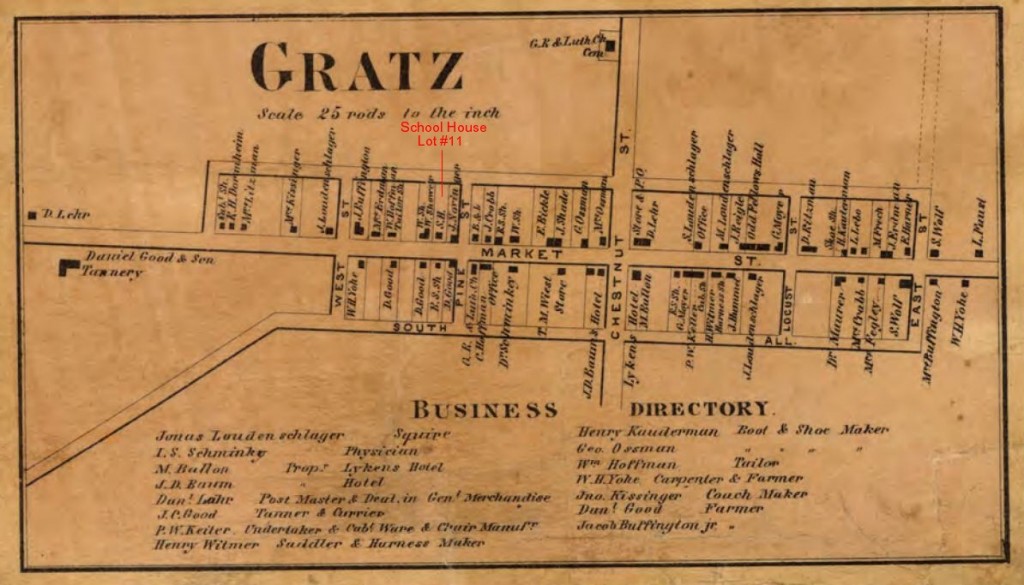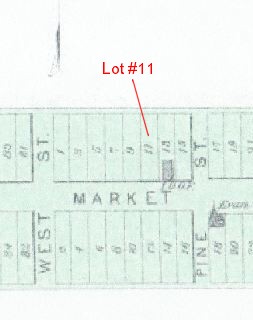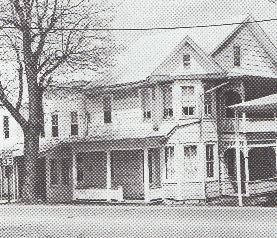Gratz During the Civil War – First Public School
Posted By Norman Gasbarro on June 19, 2011
This is the second part in a series on Civil War Gratz. This post focuses on the first public school in Gratz which was on Lot #11. The 1862 map of Gratz has a space marked “S.H.” where the school house existed. Most records indicate that there was a free public school located on Lot #11, which should be actually located one lot to the west of the one marked “S.H.” Counting the lots on the north side of Market Street between West Street and Pine, it can be noted that one lot is missing. The map is probably not drawn to scale and there was probably a vacant lot that the mapmaker failed to note on this 1862 map. Eight lots are shown on the 1829 and 1876 maps but only seven lots are shown on the 1862 map.
Records from 1838 indicate that this lot was purchased by the “Common School Society.” Early common school trustees were Christian Enterline, Michael Williard, J. B. Crain and Daniel Good. Free Public Schools had been created in 1834 and by 1858 a school district was established to coordinate laws for all public school schools. The school district was called the Free School Society and the county records indicate that at that time, the Free School Society owned the lot and the building at this site. The trustees were prominent individuals in the early history of Gratz and undoubtedly were interested in education for their own children as well as the children of the community. This remained as the Gratz Free School until 1871 when the property was sold and a new school was built on Center Street across from Simeon’s Church. Today, there is a monument at the site where the 1871 school stood.
One of the earliest pictures that has been found of the first Gratz school is from 1905 and was taken after the owner made a significant Victorian-style addition to the east side of the small building. Pictured below is the 1905 addition (at right in picture). The original school building, dating from perhaps 1822 when it was a small, two-story house, is believed to be at the left in the picture. This was the only known school in Gratz during the Civil War.
Records available to the Civil War Research Project indicate that in 1860, only one teacher was employed to teach about ninety enrolled students, about forty-five of whom would report on any given day. The school year began on 15 October and lasted for six months. The teacher was paid $25 per month. Teacher training was done in Harrisburg at “Institutes” conducted by the county and this training was interrupted by the Civil War. The 1863-1864 school term saw an outbreak of smallpox and Institute classrooms in Harrisburg were used as a hospital for the smallpox victims. In addition, the closeness of the war to Harrisburg in 1863 disrupted the county’s efforts to coordinate instruction. Teachers were also young men who were eligible for military service. The records show that the Gratz School employed men who later served in the war as well as veterans of the war.
Teachers at the Gratz School during the Civil War period were: (1) Jonas Keiser, was empoyed intermittently during the years 1855-1863. His teaching service was interrupted by military service in the Civil War. After the war, he moved to Delaware. Jonas is named on the Lykens G.A.R. Monument. (2) Rudolph Dornheim, whose dates of teaching were not recorded. He moved to Philadelphia around 1910 but is buried in Gratz Union Cemetery. Dornheim was a cabinetmaker and also saw service in the Civil War. (3) William H. Showers, whose home was next to the school (Lot #9), was a teacher in 1858 and then returned to teach from 1861 to 1863. No record of Civil War service for him has been found. (4) Henry Umholtz taught “high school” just prior to the war in about 1860. The school was probably not “graded” during the Civil War period, so this reference may be to learning beyond the basics rather than a specific age or grade level student. (5) Cyrus K. Snyder taught from about 1863 to 1869. Perhaps this was the same Cyrus Snyder who was from Mifflin Township, Dauphin County, and who served in the 173rd Pennsylvania Infantry, completing his service in August 1863. The veteran Cyrus Snyder is named on the Lykens G.A.R. Monument and is buried in Wiconisco Cemetery. (6) John W. Hoffman, a Civil War veteran taught from 1867 to 1870, and then again in some years through 1877. Presumably, this is the John W. Hoffman who is buried in the Gratz Union Cemetery (born 1843-died1926), and not the John W. Hoffman who is buried in the Peace Cemetery in Berrysburg (born1836-died1907). Both had Civil War service and one is named on the Lykens G.A.R. Monument.
A more recent picture shows the first school building as it appeared around 1997. The building is still standing today.
About twenty years ago, the Gratz Historical Society obtained the minutes book of this Gratz school. The minutes cover the period from 1859 to 1869 and conclude with the ordering of brick for the new school which was completed by 1871. A summary of this minutes book was given in A Comprehensive History of the Town of Gratz Pennsylvania as was a complete history of the Gratz schools.
The history of Lot #11 is found in A Comprehensive History of the Town of Gratz Pennsylvania, p. 77-96 and p. 137-140. The history of schools in Gratz is found in the same reference, p. 694-719. The Gratz Historical Society also maintains a collection of materials on all the schools in Gratz and the surrounding area and some of these materials are displayed in the school exhibit in the Gratz Historical Society Museum. In addition there is a collection of photo albums and later yearbooks from the schools of the area. Finally, one of the buildings of the Gratz Historical Society is a one-room school house in Erdman, Lykens Township, Dauphin County. Annual programs are held at the school which is set-up very much as it would have been at the beginning of the 20th Century when one-room school houses were the major sites of public education in rural America.
 ;
;






Comments